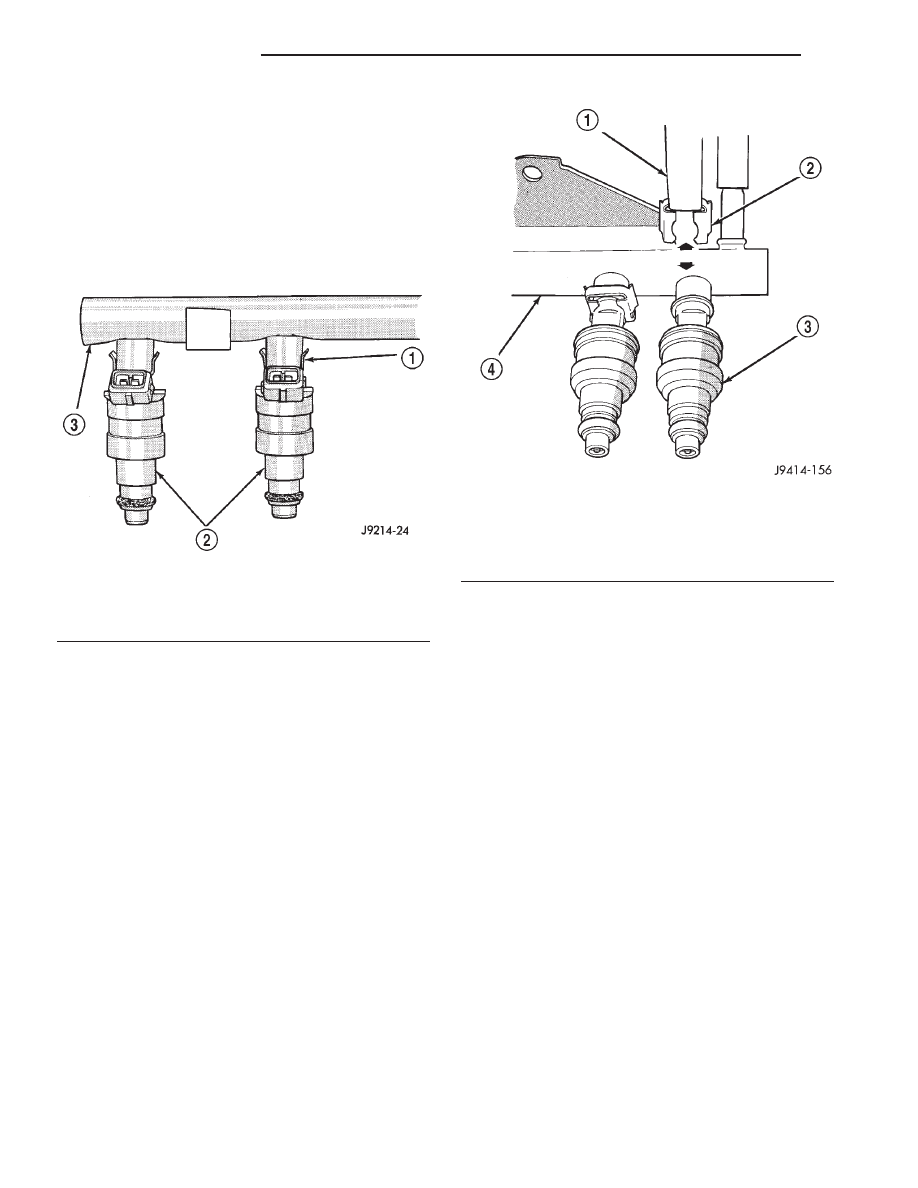Dodge Dakota (R1). Manual - part 561

(11) Gently rock and pull left fuel rail until fuel
injectors just start to clear intake manifold. Gently
rock and pull right fuel rail until fuel injectors just
start to clear intake manifold. Repeat this procedure
(left/right) until all fuel injectors have cleared intake
manifold.
(12) Remove fuel rail (with injectors attached)
from engine.
(13) Remove clip(s) retaining injector(s) to fuel rail
(Fig. 24) or (Fig. 25).
REMOVAL - 4.7L
WARNING: THE FUEL SYSTEM IS UNDER CON-
STANT
PRESSURE
EVEN
WITH
ENGINE
OFF.
BEFORE SERVICING FUEL RAIL, FUEL SYSTEM
PRESSURE MUST BE RELEASED.
CAUTION: The left and right fuel rails are replaced
as an assembly. Do not attempt to separate rail
halves at connector tube (Fig. 26). Due to design of
tube, it does not use any clamps. Never attempt to
install a clamping device of any kind to tube. When
removing fuel rail assembly for any reason, be care-
ful not to bend or kink tube.
(1) Remove fuel tank filler tube cap.
(2) Perform Fuel System Pressure Release Proce-
dure.
(3) Remove negative battery cable at battery.
(4) Remove air duct at throttle body air box.
(5) Remove air box at throttle body.
(6) Remove wiring at rear of generator.
(7) Disconnect fuel line latch clip and fuel line at
fuel rail. A special tool will be necessary for fuel line
disconnection. Refer to Quick-Connect Fittings.
(8) Remove vacuum lines at throttle body.
(9) Disconnect electrical connectors at all 8 fuel
injectors. To remove connector refer to (Fig. 27). Push
red colored slider away from injector (1). While push-
ing slider, depress tab (2) and remove connector (3)
from injector. The factory fuel injection wiring har-
ness is numerically tagged (INJ 1, INJ 2, etc.) for
injector position identification. If harness is not
tagged, note wiring location before removal.
(10) Disconnect electrical connectors at throttle
body.
(11) Disconnect electrical connectors at MAP and
IAT sensors.
(12) Remove first three ignition coils on each bank
(cylinders #1, 3, 5, 2, 4 and 6). Refer to Ignition Coil
Removal/Installation.
(13) Remove 4 fuel rail mounting bolts (Fig. 26).
(14) Gently rock and pull left side of fuel rail until
fuel injectors just start to clear machined holes in
cylinder head. Gently rock and pull right side of rail
until injectors just start to clear cylinder head holes.
Repeat this procedure (left/right) until all injectors
have cleared cylinder head holes.
(15) Remove fuel rail (with injectors attached)
from engine.
(16) If fuel injectors are to be removed, refer to
Fuel Injector Removal/Installation.
Fig. 24 Fuel Injector
1 - CLIP
2 - INJECTOR
3 - FUEL RAIL
Fig. 25 Injector Retaining
1 - PLIERS
2 - INJECTOR CLIP
3 - FUEL INJECTOR
4 - FUEL RAIL
14 - 16
FUEL DELIVERY
AN
FUEL RAIL (Continued)